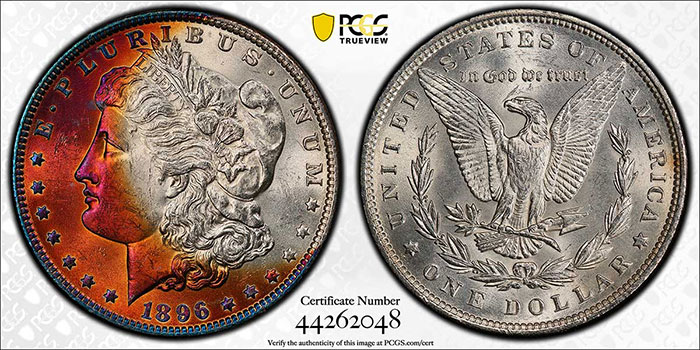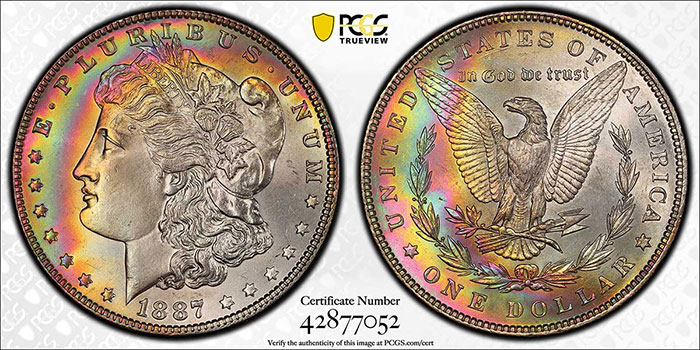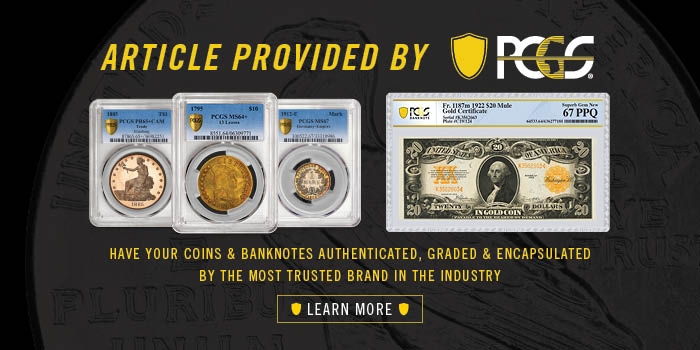By Kyle Clifford Knapp for PCGS ……
An 1881-S Morgan Dollar graded PCGS MS67+ and bearing a price guide value of $1,100 realized $19,387 USD. A PCGS MS65 1885-O in MS65 with a price guide listing of $250 brought $8,812.50. It’s not inflation! The drama of the prices at the last Central States Numismatic Society (CSNS) Convention in Illinois was matched only by the dazzle of the coins themselves. Colorfully toned Morgan Dollars, with surfaces oxidized just enough to radiate an electrified, oversaturated version of the polychromatic patination of a fine silverware set long untouched, have always catalyzed heart rates and bidder paddles.

“Rainbow” toning can arise from prolonged exposure to any of a multitude of reactive environments. Wayne Miller’s Morgan and Peace Dollar Textbook, the authoritative reference on the series, includes several color plates illustrating spectacular examples. The most vividly hued Morgan Dollars, like the 1882-S pictured above, are those which were toned as a result of being stored in the sulfur-rich canvas bags (each containing 1,000 pieces) used by the United States Mint. The enormous outputs demanded by the Bland-Allison Act resulted in large quantities of coins – most notably San Francisco issues from the early years of the series – remaining untouched in government vaults for decades. The release of the Continental Bank Hoard in 1982 spurred interest by bringing many choice pieces to the market. The “textile” pattern seen on the face of this piece mirrors the thickly woven fabric of the bag.
More complex, geometric patterns arise from long-term storage against the folded, sulfur-rich ends of a paper coin roll. The pictured PCGS MS66+ 1888-O was famously featured on the poster for a Mid-America Coin Auctions sale in 1988. In 2014, it realized $20,562.50 – still a record price for any example of the date.

The strong prices that such pieces command is the product of both the passion they inspire from collectors with a keen eye for aesthetics and their relative scarcity. Coins must remain undisturbed near an oxidation source for many years for the thickness of the resultant thin-film layer to be just enough to impart dazzling color without pitching the surfaces into luster-eroding darkness. In any given bag of 1,000 pieces, it is generally only those few resting against the surface of the canvas that have even the theoretical opportunity to tone in such an attractive fashion.
Artificial toning, or the intentional, accelerated oxidation of a coin, was historically employed largely as a concealing or obfuscating device. Writing for prospective buyers in the pre-certification era, Miller warns of traps such as supposedly uncirculated examples of the rare 1892-S having light amounts of circulation hidden beneath the oxide veil, or 1921 Peace Dollars with color added to muddle evidence of an incomplete strike.
However, as premiums for spectacular toning have increased in recent decades, attempts to add valuable artificial patination to otherwise problem-free or even Gem-quality coins have been made. When seeking to distinguish artificial from original color, it is perhaps most helpful to examine the palettes and progressions of those most well-substantiated genuine pieces and use their aesthetic as a template or standard when considering new pieces.

Mint-bag toning on Morgan Dollars should proceed in thickening iterations of yellow, magenta, and cyan. The 1880-S shown above illustrates this pattern, repeated twice and covering the entirety of the obverse; it is very likely a Continental Hoard coin. Upon close examination, one will find that even the narrowest of rainbow “crescents” also follow this three-toned pattern.
The pictured 1896 has coloration in a crescent shape, purporting to be a mint-bag toned example, but note the over-dominance of an unnatural fruit-drink red-orange. Contrast this hue with the vivid, fiery magenta band near the top of the 1880-S. This piece is artificially toned.

The imaged 1887-P also demonstrates an inappropriate color palette: the artificial pastel hues lack the energy and vigor of natural color and appear to float atop the surface rather than integrating with the coin’s luster and surface fabric. Also, note the duplication of similar patterns on the obverse and reverse of the same piece. While not impossible, this is quite unusual on natural pieces, as it would require long-term storage with oxidation sources near both sides.
While the intimidating prices of the most jaw-dropping examples may relegate them to the cabinets of a select few, many beautifully toned Morgan Dollars can still be acquired at the three- and low-four-figure price points. As with all forms of patination, multicolored toning attests to a surface’s originality and stability, adds identity and character to what can be otherwise common issues, and, in its best form, motivates sophisticated collectors to dispatch with price guides, population reports, and inhibitions.
* * *





